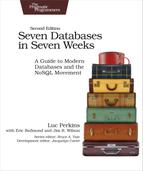Appendix
1
Database Overview Tables
This book contains a wealth of information about each of the seven databases we discuss: PostgreSQL, HBase, MongoDB, CouchDB, Neo4j, DynamoDB, and Redis. In the pages that follow, you’ll find tables that tally up these databases along a number of dimensions to present an overview of what’s covered in more detail elsewhere in the book. Although the tables are not a replacement for a true understanding, they should provide you with an at-a-glance sense of what each database is capable of, where it falls short, and how it fits into the modern database landscape.
Genre | Version | Datatypes | Data Relations | |
|---|---|---|---|---|
PostgreSQL | Relational | 9.1 | Predefined and typed | Predefined |
HBase | Columnar | 1.4.1 | Predefined and typed | None |
MongoDB | Document | 3.6 | Typed | None |
CouchDB | Document | 2.1.1 | Typed | None |
Neo4j | Graph | 3.1.4 Enterprise | Untyped | Ad hoc (Edges) |
DynamoDB | Key-value (or “key-value plus,” for reasons explained in chapter 7) | API version 2012-08-10 | Typed | Predefined tables (plus support for arbitrary fields) |
Redis | Key-value | 4.0 | Semi-typed | None |
Standard Object | Written in Language | Interface Protocol | HTTP/REST | |
|---|---|---|---|---|
PostgreSQL | Table | C | Custom over TCP | No |
HBase | Columns | Java | Thrift, HTTP | Yes |
MongoDB | JSON | C++ | Custom over TCP | Simple |
CouchDB | JSON | Erlang | HTTP | Yes |
Neo4j | Hash | Java | HTTP | Yes |
DynamoDB | Table | Unknown | JSON over HTTP | Yes |
Redis | String | C/C++ | Simple text over TCP | No |
Ad Hoc Query | Mapreduce | Scalable | Durability | |
|---|---|---|---|---|
PostgreSQL | SQL | No | Cluster (via add-ons) | ACID |
HBase | Weak | Hadoop | Datacenter | Write-ahead logging |
MongoDB | Commands, mapreduce | JavaScript | Datacenter | Write-ahead journaling, Safe mode |
CouchDB | Temporary views | JavaScript | Datacenter (via BigCouch) | Crash-only |
Neo4j | Graph walking, Cypher, search | No (in the distributed sense) | Cluster (via HA) | ACID |
DynamoDB | Limited range of SQL-style queries | No | Multi-datacenter | ACID |
Redis | Commands | No | Cluster (via master-slave) | Append-only log |
Secondary Indexes | Versioning | Bulk Load | Very Large Files | |
|---|---|---|---|---|
PostgreSQL | Yes | No | COPY command | BLOBs |
HBase | No | Yes | No | No |
MongoDB | Yes | No | mongoimport | GridFS |
CouchDB | Yes | Yes | Bulk Doc API | Attachments |
Neo4j | Yes (via Lucene) | No | No | No |
DynamoDB | Yes | Yes | No | Lewak (deprecated) |
Redis | No | No | No | No |
Requires Compaction | Replication | Sharding | Concurrency | |
|---|---|---|---|---|
PostgreSQL | No | Master-slave | Add-ons (e.g., PL/Proxy) | Table/row writer lock |
HBase | No | Master-slave | Yes via HDFS | Consistent per row |
MongoDB | No | Master-slave (via replica sets) | Yes | Write lock |
CouchDB | File rewrite | Master-master | Yes (with filters in BigCouch) | Lock-free MVCC |
Neo4j | No | Master-slave (in Enterprise Edition) | No | Write lock |
DynamoDB | No | Peer-based, master-master | Yes | Vector-clocks |
Redis | Snapshot | Master-slave | Add-ons (e.g., client) | None |
Transactions | Triggers | Security | Multitenancy | |
|---|---|---|---|---|
PostgreSQL | ACID | Yes | Users/groups | Yes |
HBase | Yes (when enabled) | No | Kerberos via Hadoop security | No |
MongoDB | No | No | Users | Yes |
CouchDB | No | Update validation or Changes API | Users | Yes |
Neo4j | ACID | Transaction event handlers | None | No |
DynamoDB | No | Pre/postcommits | None | No |
Redis | Multi operation queues | No | Passwords | No |
Main Differentiator | Weaknesses | |
|---|---|---|
PostgreSQL | Best of OSS RDBMS model | Distributed availability |
HBase | Very large-scale, Hadoop infrastructure | Flexible growth, query-ability |
MongoDB | Easily query Big Data | Embed-ability |
CouchDB | Durable and embeddable clusters | Query-ability |
Neo4j | Flexible graph | BLOBs or terabyte scale |
DynamoDB | Highly available | Query-ability |
Redis | Very, very fast | Complex data |
